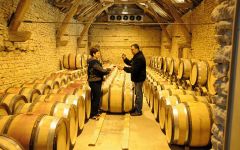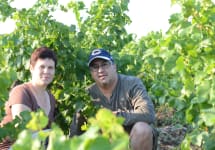Rotem & Mounir Saouma Chateauneuf-du-Pape Omnia 2015
-
Wine
Spectator - Decanter
-
Wine &
Spirits -
Jeb
Dunnuck



Product Details
Your Rating
Somm Note
Winemaker Notes
It’s high drama everywhere: intensely lifted perfume of flowers and red fruit; dense, rich fruit and power, but wild savory notes, intense stony minerality. Yet the power is somehow also so vibrant and precise. A “new old” style of Chateauneuf.
Blend: 80% Grenache, 10% Syrah, 10% Mourvedre
Professional Ratings
-
Wine Spectator
This is sublime, with beguiling rooibos tea, blood orange and sandalwood aromas out front followed by a long and silky display of lightly mulled cherry, damson plum and raspberry fruit flavors. Light shiso leaf and sanguine notes lace up the finish while the fruit echoes admirably. Best from 2020 through 2040.
-
Decanter
A very different style of Châteauneuf-du-Pape, with a particularly smoky aroma - similar to unburnt charcoal - which is likely to be at least in part through reduction rather than oak. Cherry, raspberry and touches of blackcurrant form the fruit core, backed by tobacco and allspice, although it's not fat, overly generous or flowing, but tightly austere on the mid-palate and finishing grippy, with serrated, fine-grained tannins and a great, rising salinity. A wine of formidable energy, freshness and vibrancy, which is all about structure and texture, rather than fruit. Really shows a different side of Châteauneuf, placing to the fore the mineral bones that gives Châteauneuf its ageability.
-
Wine & Spirits
The Saoumas cull this cuvée from nine parcels spread among all five villages of Châteauneuf. The light garnet hue is the first tip-off that this isn’t your usual Rhône red: It looks more like pinot noir than a grenache-focused Châteauneuf. And it tastes as transparent, with gauzy layers of cherry, spice, smoke, herbs and leaves. Weightless and graceful, those flavors take on a surround-sound feel, filling space with their fragrance. This is delicate enough to pair with salmon and mushrooms, though it deserves a few years in the cellar to fully integrate the oak.
-
Jeb Dunnuck
The 2015 Châteauneuf du Pape Omni is 80% Grenache and 10% each of Syrah and Mourvèdre. It was fermented with 100% stems, followed by two years in barrel, where it was never racked. Bottled unfined and unfiltered, it offers a translucent ruby color to go with terrific notes of black cherries, garrigue, peppery, and scorched earth. Perfumed, floral, elegant and lively on the palate, with a notable sense of freshness, it’s an outstanding Châteauneuf du Pape to drink over the coming 10-15 years.
Other Vintages
2020-
Wine
Spectator
-
Wine
Spectator -
James
Suckling
-
Wine
Spectator -
Wine &
Spirits
-
Wine
Spectator - Decanter
-
Jeb
Dunnuck
-
Wine
Spectator -
Robert
Parker




Let’s start at the beginning: five acres in Pignan. A sale was being conducted through the French state that presented the opportunity to buy a somewhat neglected parcel adjoining some outstanding plots (notably Rayas’ Bois de Rayas and the Pignan lieu-dit). The Saoumas have long loved the area and its wines, have many friends and saw they could potentially acquire land in a way that would not be possible in Burgundy. The sheer vitality of these vines today is extraordinary.
They know and love Mounir Saouma because of the way he transmits both unknown and acknowledged great crus of Burgundy through his elevage into masterpieces, but it turns out he may be an even more talented vineyard manager. Mounir’s philosophy is in theory straightforward. He has worked to improve drainage in his vineyards, works with organic manures, and doesn’t mind the low yields he is getting in his plots. As is the case with most things in life, simplicity appears only after deliberation and experience. From this plot, Mounir has been able to acquire additional vineyards, and today farms a total of 21 acres across eight vineyards in all five villages of the appellation (Chateauneuf-du-Pape, Bedarrides, Sorgues, Courthezon, and Orange).
The kaleidoscope of the terroirs he works with is reflected in the cellar, as well, where a combination of barrels, foudres, cement, and eggs are used, all except the last of which can be considered “traditional” within the diversity of Chateauneuf’s viticultural history. The fruit is pressed firmly with small presses dating from the late 1970s, left in tank to macerate at relatively cool temperatures for 8 days, and then transferred to the various vessels. The wines are never punched down, never racked, and never sulfured until a light addition a month before bottling. They age for between 24-36 months, including the white, which as you might expect has an outsized focus here.
The wines are stunning: precise, intense, complex, expressive visions of Chateauneuf.

With bold fruit flavors and accents of sweet spice, Grenache, Syrah and Mourvèdre form the base of the classic Rhône Red Blend, while Carignan, Cinsault and Counoise often come in to play. Though they originated from France’s southern Rhône Valley, with some creative interpretation, Rhône blends have also become popular in other countries. Somm Secret—Putting their own local spin on the Rhône Red Blend, those from Priorat often include Merlot and Cabernet Sauvignon. In California, it is not uncommon to see Petite Sirah make an appearance.

Famous for its full-bodied, seductive and spicy reds with flavor and aroma characteristics reminiscent of black cherry, baked raspberry, garrigue, olive tapenade, lavender and baking spice, Châteauneuf-du-Pape is the leading sub-appellation of the southern Rhône River Valley. Large pebbles resembling river rocks, called "galets" in French, dominate most of the terrain. The stones hold heat and reflect it back up to the low-lying gobelet-trained vines. Though the galets are typical, they are not prominent in every vineyard. Chateau Rayas is the most obvious deviation with very sandy soil.
According to law, eighteen grape varieties are allowed in Châteauneuf-du-Pape and most wines are blends of some mix of these. For reds, Grenache is the star player with Mourvedre and Syrah coming typically second. Others used include Cinsault, Counoise and occasionally Muscardin, Vaccarèse, Picquepoul Noir and Terret Noir.
Only about 6-7% of wine from Châteauneuf-du-Pape is white wine. Blends and single-varietal bottlings are typically based on the soft and floral Grenache Blanc but Clairette, Bourboulenc and Roussanne are grown with some significance.
The wine of Chateauneuf-du-Pape takes its name from the relocation of the papal court to Avignon. The lore says that after moving in 1309, Pope Clément V (after whom Chateau Pape-Clément in Pessac-Léognan is named) ordered that vines were planted. But it was actually his successor, John XXII, who established the vineyards. The name however, Chateauneuf-du-Pape, translated as "the pope's new castle," didn’t really stick until the 19th century.
